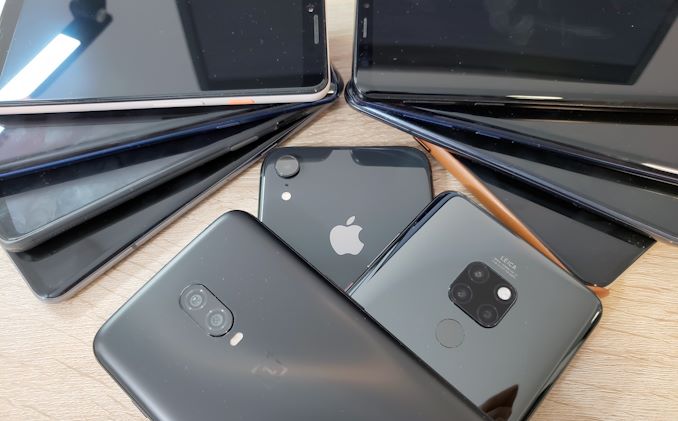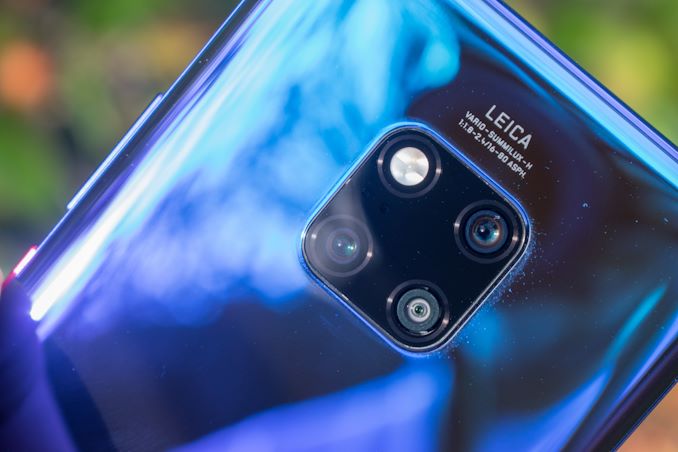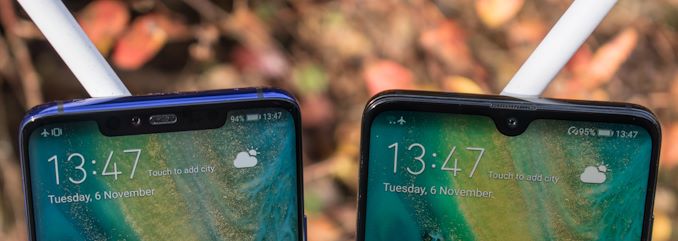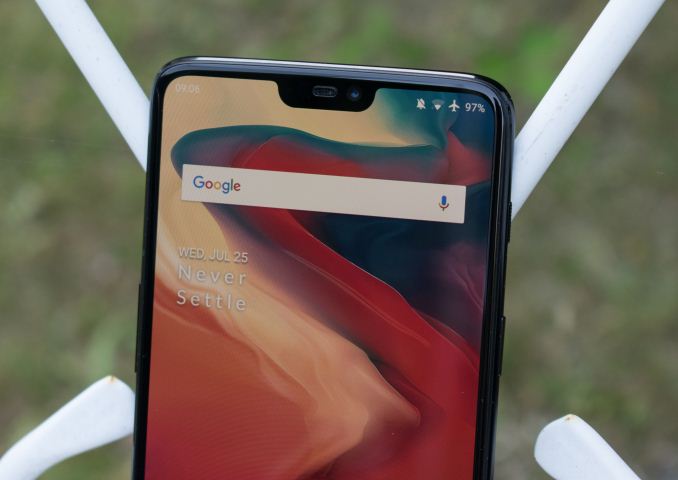AnandTech Year In Review 2018: Flagship Mobile
by Andrei Frumusanu on December 28, 2018 12:00 PM EST- Posted in
- Smartphones
- Apple
- Samsung
- LG
- Huawei
- Mobile
- SoCs
- OnePlus
- Year In Review

As we’re drawing to a close of the calendar year, it is time to look back and revisit what 2018 has brought to the mobile space. Unlike the PC industry, the mobile space follows a quite unrelenting and precise release schedule – meaning that we’re guaranteed new products every year: This can be a double-edged sword for new flagship mobile devices, as new technologies can be either ready at the leading edge of a new product cycle – or in the worst case they can miss the current generation altogether by a few months and have to be relegated to the next generation. Overall, smartphone companies have an incredibly complex task at hand in attempting to deliver products that not only represent an improvement to last year’s devices, but also to be able to distinguish themselves from the current competition. In this piece, we’ll have a closer look at the distinguishing trends of 2018 and how major players have executed their strategies this cycle.
How 2018 Will Be Remembered: Major Smartphone Camera Leaps
If I were to be asked what 2018’s flagship smartphones most defining characteristic would be, then I’d say their cameras. Essentially every vendor in 2018 has made significant leaps in terms of their camera performance, improving quality and adding new features. This year more than ever, we saw a significant amount of products make the camera their key selling point.
Starting off early in the year, Samsung lead the way with the release of the Galaxy S9. The S9’s camera on paper wasn’t too unusual, apart from the fact that the main camera module employed a new innovative dual-aperture mechanism. Samsung’s gains here were defined by sheer improvements of the camera hardware: The new sensor along with the new lens mechanism had raised the bar in terms of overall detail and sharpness, an aspect of the camera in which Samsung still maintains top marks up till today.
Another player whose camera improvements can be attributed to significant hardware leaps is Apple. The new iPhone XS and XR’s new camera module saw a major improvements in the sensor, with new larger pixels as well as a notably improved DTI implementation. The combination of great hardware and robust and consistent software processing made the new iPhone XS one of the best cameras of 2018.
The Year Where Camera Software Outshone Camera Hardware
Although Samsung’s and Apple’s camera improvements were significant – it was more or less an expected result of the newer generation hardware. While the hardware advances this year were solid, nothing left a quite an as quite as lasting impression as Huawei’s new computational photography on the P20 Pro and Mate 20 Pro.
[ Mate 20Pro ] - [ P20Pro ] - [ Pixel 3 ]
[ iPhone XS ] - [ S9+ ] - [ LG G7 ] - [ OnePlus 6 ]
Night mode on Huawei devices was something that was part of the company’s camera experience for a couple of years now – but it required use of a tripod to be able to get good results. The introduction of a new revamped hand-held Night Mode on the P20 Pro sparked a new era of true computational photography, achieving new levels of low-light performance that in the past would have been hard to imagine on a smartphone.
It’s only been recently, and almost half a year later that other companies followed suit: Most notable was Google’s “Night Sight” mode that was announced along the Pixel 3, with the feature also coming to the Pixel 2 and original Pixel. Here Google was able to one-up Huawei in terms of the low-light processing prowess.
I do think Huawei deserves a lot of credit for being a pioneer in terms of its use of computational photography: We’ve seen already many companies such as OnePlus and Xiaomi release new models and new camera software updates which bring night mode implementations of their own. I really do expect this feature to be a key checkmark item for smartphone vendors in 2019, with essentially all other major vendors following suit with new custom implementations.
The More Cameras the Merrier?
Another big trend by which 2018 smartphones will be remembered by, is the increasing amount of cameras on a smartphone. This year in particular has been pretty much the year in which having a telephoto module on your smartphone has become a mainstream feature. There’s still exceptions to this, particularly the smaller S9 from Samsung, along with Google’s Pixel phones. Vendors who don’t have a telephoto module per se, do still offer some added functionality with a second sensor; LG continued with its use of a wide-angle lens in the G7, while vendors such as OnePlus advertise the second sensor as being used for depth information.
In the last months of 2018 we saw the increase in camera modules go quite in the extreme: Instead of having to choose between either a telephoto or a wide-angle module, vendors such as Huawei, LG and Samsung have now started offering the trifecta of rear-camera configurations. Huawei’s introduction of a wide-angle module in the new Mate 20 and Mate 20 Pro make for a great addition to the capture experience, and we now finally see an alternative to LG in terms of seeing another major device offering the feature. Conversely, we also saw LG going the three-camera route in the new V40, adding for the first time a telephoto module in its new flagship. Much like the “night mode”, I expect the camera trifecta to be a key checkmark feature for flagship devices in 2019.
How 2018 Will Also Be Remembered: The Display Notch and its Repercussions
Apple’s 2017 iPhone X was the phone that pretty much “popularised” the display notch. While Apple wasn’t exactly the first company to introduce this, it paved the way for other companies to introduce designs that, wouldn’t it have been for the iPhone X, maybe wouldn’t have come to market with the designs that they did end up with.
Now I personally never really felt all that strongly about display notches for most of 2018: It was just something that I acknowledged to be there, but otherwise wasn’t neither a big positive nor negative for the phones. Huawei’s, LG’s and OnePlus’s first implementations this summer all worked quite seamlessly, and all of them allowed for “blacking out” the notch ears if one so wished.
Among Android devices, I think the only questionable implementations of the notch were on the Pixel 3 XL and on the Mate 20 Pro. The former just had an absurdly tall double-height notch that aesthetically just really wasn’t pleasant, all while having much inferior software options in terms of customising the “ears”. The Mate 20 Pro’s notch is the one that was most similar to the iPhone X; both in terms of functionality as well as design. Here I think the wider design actually hindered things on the software side, as I felt there wasn’t enough space left for the notification bar elements.
Now there’s arguably a lot of discussion if the display notch is worth it, but one thing that every company seems to agree on is that this is just an interim solution while everybody is working towards the goal of bezel-less devices. In fact, some companies this year have resorted to some quite radical designs; The Oppo Find X has a motorised camera housing sliding out of the top of the phone, hiding both front-facing and rear-facing cameras beneath the front screen and back glass. Another implementation is adopted by Honor, Xiaomi and Lenovo, devices such as the Honor Magic 2, Mi MIX3 and the new Z5 Pro, where the whole front-screen is mounted on a sliding mechanism, while the main body houses the internals as well as the camera hardware.
These solutions are quite innovative, however I do think they’re impractical and sacrifice a lot (Increased weight, lesser or no IP rating, and available thickness available to the camera modules) just for the goal of having a bezel-less display.
In general I feel less certain about where 2019 will lead us in terms of solving the display bezel/notch issue. Obviously there’s all eyes on Samsung as being one of the only hold-outs for most of 2018 who have resisted in adopting any model with a notch – here the company was quite public about its plans to adopt “Infinity-V” and “Infinity-O”, the former which is a usual V-shaped notch, while the latter will be using hole-in-active-display design.














65 Comments
View All Comments
mmrezaie - Friday, December 28, 2018 - link
For me, the main dealbreaker is providing timely OS updates. Even oneplus fails me on this. I got moto x4 and for a bit lower than 250usd, and I have android 9. this cannot be said about most of the phone came to market in 2017.mmrezaie - Friday, December 28, 2018 - link
I am not trying to say Motorola is better (far from it). I was just lucky!pjcamp - Saturday, December 29, 2018 - link
Since Lenovo bought them, updates have ceased to exist.mmrezaie - Saturday, December 29, 2018 - link
I know for most of their phones but for moto x4 I got android 9 before onplus and samsung phones of the time that I purchased it. I wish there was a way to know before buying these phones if the companies are going to "really" continue to support their phones or not.goatfajitas - Sunday, December 30, 2018 - link
Spoken as a long time Android fan, to me, in a lot of ways Google has "lost the plot" with Android... However timely updates was never a part of whatever plot that was lost. I am far more concerned about the lack of anything really great update since KitKat. Android 5 was fully 64 bit and buggy, 6 just fixed bugs and I honestly dont care at all about anything added in 7,8,9. It's still buggy, it still bloaty, it's still easily corruptible. What a disappointing 5 years it has been for Android and it's OEM's.Haawser - Sunday, December 30, 2018 - link
I bought a Mi A2 Lite, which is an Android One device, so it has no bloatware and runs stock Android. I think a lot of OEMs butcher Android so much with skins, background apps and bloatware that they end up a mess. But plain old Pie tastes great so far.goatfajitas - Monday, December 31, 2018 - link
I have a Pixel 2XL. Not alot of bloat either but there are still issues. Issues that a 10 year old OS shouldn't still have. I really thought this crap would be fixed by now.EnzoFX - Monday, December 31, 2018 - link
This and the underwhelming hardware, especially the Pixel line, which I guess if you must have the stock os (which I alwas did go for) and camera, never felt like a flagship phone, not to merit it's price. Iffy updates and disappointing directions finally got me to switch to iOS.goatfajitas - Tuesday, January 1, 2019 - link
Yeah, the Pixel 3XL is a joke. Nice if it was released at $499, but $899? forget it.nydude25 - Friday, January 4, 2019 - link
Same here, with a Moto X4 updated to Pie since before Christmas.And it has a 3.5mm headphone port too.